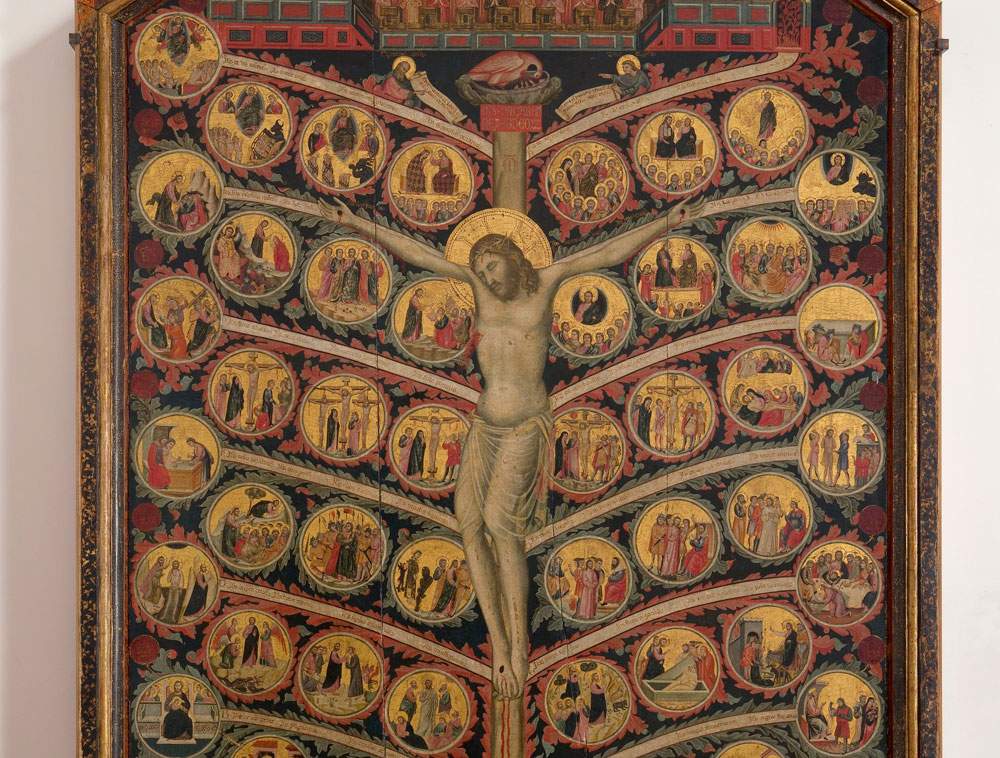The Bargello for Dante: Pacino di Buonaguida's Tree of Life on display
On the occasion of the celebrations of the 700th anniversary of Dante Alighieri’s death, Pacino di Buonaguida ’sTree of Life will go on loan to the Bargello Museums from the collections of the Galleria dell’Accademia in Florence for the exhibition Honorable and Ancient Citizen of Florence. The Bargello for Dante. The exhibition will be open to the public from March 23, 2021, and will kick off a collaboration between the two Florentine institutions for other future events.
TheTree of Life is a tempera and gold panel painting attributed to Pacino di Buonaguida, dated around 1310-1315. It is very significant because it translates in images, in detail, the themes of the Lignum vitae, a treatise written by St. Bonaventure of Bagnoreggio, in 1274. In the center is Christ crucified to a tree with twelve branches, from each hangs four medallions with episodes from the life of Jesus; the last, upper right, has only three because the final scene is depicted in the cusped top of the painting, where the Redeemer and the enthroned Virgin tower above the host of saints, angels and blessed. At the bottom are the stories of Genesis, while, on the just upper register, to the left are the stories of Moses and St. Francis, and, to the right, those of St. Clare and St. John the Evangelist. The tree stands above a rock, inside which is a cave in which a Franciscan with an open book in his hand can be glimpsed: this is probably the author of the text, St. Bonaventure. As scholar Maria Ciardi Duprè Dal Poggetto pointed out at the time, it would be one of the oldest depictions of the theological-philosophical themes of the spiritual current of the order.
The work was originally in the Monastery of the Poor Clares of Monticelli, from where it passed to the community of Via dei Malcontenti in Florence, where the Franciscan nuns moved in 1531 from their headquarters outside Porta Romana. She remained there until the Napoleonic suppressions of 1808 and was later taken to Montedomini, where she was found in October 1849. In 1850 it was already reported to be in the Exhibition Hall of the Accademia Gallery.
The attribution to Pacino was due to German art historian Henry Thode in 1885. Pacino was a painter and miniaturist active in Florence in the first half of the 14th century, but there is very little information about him. Pacino’s efforts were greatest, in particular, in the production of illuminated manuscripts of Dante’s Divine Comedy, to the point that with the help of his workshop he was able to set up as many as twenty-five copies of the poem, which were of a fair standard and significant for the fortunes of the text. In theTree of Life and its many narrative episodes, this miniaturist streak of his can be seen. The panel also testifies to the artist’s attention to Giotto, but also to the Paragiottesque tendencies of early 14th-century Florentine painting. The Crucifix seems to be inspired by the Crucifix in the Church of San Felice in Piazza in Florence, made by Giotto just after his return from Padua.
"TheTree of Life is a painting that, because of the structural complexity of the panel and to safeguard the integrity of its preservation, is difficult to move," says Cecilie Hollberg, director of the Accademia Gallery in Florence. “The work that has been engaging the museum for months has meant that the work necessarily had to be moved. This made it possible to schedule the work so that it could be loaned to the Bargello Museums. This is a concrete sign of a fruitful cooperation with Director D’Agostino with whom we are putting together other projects that will soon see the light of day.”
"The curators of the exhibition and I are very grateful to Director Hollberg because the Lignum vitae represents a major addition to the exhibition Honorable and Ancient Citizen of Florence. The Bargello for Dante," explains Paola D’Agostino, director of the Bargello Museums. "The display of the panel will make it possible to grasp the dialogue between the painting on a gold background and the miniature as well as reveal the sense of the compositional solutions that Pacino later adopted on a monumental scale, becoming one of the very first illustrators in Florence of the Commedia. We are also delighted to have established a synergistic relationship with Cecilie Hollberg, which allows us to exhibit this work at the Bargello Museum, subtracting it from the period that it would inevitably have been in storage, given the unfinished work at the Accademia Gallery."
Pictured, Pacino di Buonaguida, Tree of Life, detail.
 |
| The Bargello for Dante: Pacino di Buonaguida's Tree of Life on display |
Warning: the translation into English of the original Italian article was created using automatic tools. We undertake to review all articles, but we do not guarantee the total absence of inaccuracies in the translation due to the program. You can find the original by clicking on the ITA button. If you find any mistake,please contact us.





























